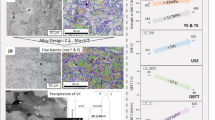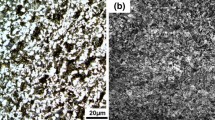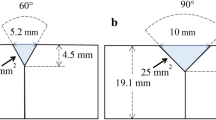Abstract
To apply the leak-before-break (LBB) design to main steam line (MSL) piping in nuclear power plants, higher strength and relatively tough SA508 Gr.1A steel were developed by changing the alloy design and fabrication process. Two actual-size prototype types of MSL piping (M1 and M2) with different contents of C, Mo, and V were fabricated and their mechanical properties were evaluated and compared with those of commercial SA508 Gr.1A steel. In the alloy design, the content of C was decreased to reduce the degree to which cementite deteriorated the toughness, and Mo and V were added to increase the strength by forming bainite and VC precipitates. During the fabrication process, the thickness of the MSL piping was minimized by rough machining before a heat treatment to increase the strength by increasing the cooling rate during quenching. Both prototype steels had better strength and toughness than commercial steel. In particular, the mechanical properties of M2 with lower alloy contents had a good combination of strength and toughness. The yield strength, USE, and JIc of M2 were 407 MPa, 393 J and 680 kJ/m2 at 286 °C, respectively, which were increased by 167 MPa, 90 J, and 98 kJ/m2 compared to the correspondingly parameters of commercial steel. The LBB margin of MSL piping using M2 steels was 1.49, which was a 30% higher than those using commercial steels.
Graphical Abstract












Similar content being viewed by others
Data Availability
The raw/processed data required to reproduce these findings cannot be shared at this time as the data also form part of an ongoing study.
References
NUREG-1061, Evaluation of Potential for Pipe Breaks, in Report of the U.S. Nuclear Regulatory Commission Piping Review Committee, USNRC Report, vol. 3 (U.S. Nuclear Regulatory Commission, Washington, 1984)
NUREG-800, Leak Before Break Evaluation Procedure, in Standard Review Plan for the Review of Safety Analysis Reports for Nuclear Power Plants: LWR Edition, USNRC Report, section 3.6.3 (U.S. Nuclear Regulatory Commission, Washington, 1987)
W. Yu, A study on Applicability of Improved Material Specification for Enhancing Safety Margin of Nuclear Pipings, KAERI Report, KAERI/CM-786/2004 (Korea Atomic Energy Research Institute, Daejeon, 2004)
P. Dillström, W. Zang, ProLBB - A Probabilistic Approach to Leak Before Break Demonstration, SKI Report 2007:43 (Swedish Nuclear Inspection Authority (SKI), Stockholm, 2007)
S. Hong, J. Kim, M.W. Kim, H.D. Kim, B.S. Lee, M.C. Kim, Int. J. Pres. Ves. Pip. 188, 104226 (2020). https://doi.org/10.1016/j.ijpvp.2020.104226
S. Hong, S.-M. Hyun, J.-M. Kim, Y.-S. Lee, M.-C. Kim, Metall. Mater. Trans. A 53, 1499 (2022). https://doi.org/10.1007/s11661-022-06616-2
S. Hong, K.-D. Min, S.-M. Hyun, J. Kim, Y.-S. Lee, H.-D. Kim, M.-C. Kim, Int. J. Pres. Ves. Pip. 191, 104359 (2021). https://doi.org/10.1016/j.ijpvp.2021.104359
ASTM A508/A508M-16, Standard Specification for Quenched and Tempered Vacuum-Treated Carbon and Alloy Steel Forging for Pressure Vessels (ASTM International, West Conshohocken, 2016)
ASTM E8/E8M-16, Standard Test Methods for Tension Testing of Metallic Materials (ASTM International, West Conshohocken, 2016)
ASTM E23-18, Standard Test Methods for Notched Bar Impact Testing of Metallic Materials (ASTM International, West Conshohocken, 2018)
W. Oldfield, ASTM Stand. News 3, 24 (1975). https://www.osti.gov/biblio/6253423
ASTM E1820-16, Standard Test Method for Measurement of Fracture Toughness (ASTM International, West Conshohocken, 2016)
H. Lee, Microstructure Characterization and Effect of second phase on Mechanical Properties of HSLA Steels, Doctoral dissertation, Pohang University of Science and Technology (2008)
H.K.D.H. Bhadeshia, Bainite in Steels: Theory and Practice, 3rd edn. (CRC Press, Boca Raton, 2015)
T. Araki, I. Kozasu, H. Tankechi, K. Shibata, M. Enomoto, H. Tamehiro, Atlas for Bainitic Microstructures, vol. 1 (Iron and Steel Institute of Japan, Tokyo, 1992)
G. Krauss, S.W. Thompson, ISIJ Int. 35, 937 (1995). https://doi.org/10.2355/isijinternational.35.937
S.C.-C. Wang, P.-W. Kao, J. Mater. Sci. 28, 5169 (1993). https://doi.org/10.1007/BF00570058
J. Kong, L. Zhen, B. Guo, P. Li, A. Wang, C. Xie, Mater. Design 25, 723 (2004). https://doi.org/10.1016/j.matdes.2004.03.009
Y.M. Kim, S.Y. Shin, H. Lee, B. Hwang, S. Lee, N.J. Kim, Metall. Mater. Trans. A 38, 1731 (2007). https://doi.org/10.1007/s11661-007-9197-3
T.N. Baker, Processes. Mater. Sci. Technol. 25, 1083 (2009). https://doi.org/10.1179/174328409X453253
A.D. Batte, R.W.K. Honeycombe, Met. Sci. J. 7, 160 (1973). https://doi.org/10.1179/030634573790445370
S.Y. Han, S.Y. Shin, C.-H. Seo, H. Lee, J.-H. Bae, K. Kim, S. Lee, N. Kim, Metall. Mater. Trans. A 40, 1851 (2009). https://doi.org/10.1007/s11661-009-9884-3
T. Siwecki, J. Eliasson, R. Lagneborg, B. Hutchinson, ISIJ Int. 50, 760 (2010). https://doi.org/10.2355/isijinternational.50.760
S. Nafisi, M. Arafin, R. Glodowski, L. Collins, J. Szpunar, ISIJ Int. 54, 2404 (2014). https://doi.org/10.2355/isijinternational.54.2404
H. Gwon, S. Shin, J. Jeon, T. Song, S. Kim, B.C. De Cooman, Met. Mater. Int. 25, 594 (2019). https://doi.org/10.1007/s12540-018-00224-9
J.-H. Yoon, B.-S. Lee, J.-H. Hong, Met. Mater. Int. 7, 505 (2001). https://doi.org/10.1007/BF03027094
J.H. Kim, Y.J. Oh, I.S. Hwang, D.J. Kim, J.T. Kim, J. Nucl. Mater. 299, 132 (2001). https://doi.org/10.1016/S0022-3115(01)00688-2
R.J. Klassen, M.N. Bassim, M.R. Bayoumi, H.G.F. Wilsdorf, Mater. Sci. Eng. 80, 25 (1986). https://doi.org/10.1016/0025-5416(86)90299-5
B.S. Lee, Y.J. Oh, J.H. Yoon, I.H. Kuk, J.H. Hong, Nucl. Eng. Des. 199, 113 (2000). https://doi.org/10.1016/S0029-5493(99)00061-8
J.H. Yoon, B.S. Lee, Y.J. Oh, J.H. Hong, Int. J. Pres. Ves. Pip. 76, 663 (1999). https://doi.org/10.1016/S0308-0161(99)00033-2
S.-M. Hyun, S. Hong, M.-C. Kim, J. Kim, S.S. Sohn, S.-I. Hong, Mater. Sci. Eng. A 811, 141069 (2021). https://doi.org/10.1016/j.msea.2021.141069
S.-M. Hyun, S. Hong, M.-C. Kim, J. Kim, S.S. Sohn, Met. Mater. Int. (2022) https://doi.org/10.1007/s12540-022-01188-7
S. Hong, J. Song, M.-C. Kim, K.-J. Choi, B.-S. Lee, Met. Mater. Int. 22, 196 (2016). https://doi.org/10.1007/s12540-016-5568-x
Z. Pei, R. Song, Y. Feng, J. Xu, Met. Mater. Int. 27, 4517 (2021). https://doi.org/10.1007/s12540-020-00707-8
D. Choi, H. Lee, S.-K. Cho, H.C. Kim, S.-K. Hyun, S.Y. Shin, Met. Mater. Int. 26, 867 (2020). https://doi.org/10.1007/s12540-020-00626-8
N. Amirjani, M. Ketabchi, M. Eskandari, M. Hizombor, Met. Mater. Int. 27, 4802 (2021). https://doi.org/10.1007/s12540-020-00841-3
D.M. Norris, B. Chexal, PICEP: Pipe Crack Evaluation Program (Revision 1), Technical Report, EPRI-NP-3596-SR-Rev.1 (Electric Power Research Inst., Palo Alto, 1987)
V. Kumar, M.D. German, Elastic-plastic fracture analysis of through-wall and surface flaws in cylinders, Technical Report (Electric Power Research Institute, Washington, 1988)
M.-W. Kim, Y.-S. Lee, I.-W. Shin, J.-S. Yang, H.-D. Kim, Trans. of the KPVP 16, 42 (2020)
Acknowledgements
This work was supported by the National Research Foundation of Korea (NRF) grant funded by the Korea government (MSIP) (2021M2E4A1037978) and by the project “Development of Technologies for Improving Mechanical Properties of Main Steam Piping” funded by KHNP.
Author information
Authors and Affiliations
Corresponding author
Ethics declarations
Conflict of interest
The authors declare that they have no conflicts of interest.
Additional information
Publisher's Note
Springer Nature remains neutral with regard to jurisdictional claims in published maps and institutional affiliations.
Rights and permissions
About this article
Cite this article
Hong, S., Hyun, SM., Kim, J. et al. Effects of the Alloy Design and Fabrication Process on Mechanical Properties of Mo + V-Added SA508 Gr.1A Steel for Main Steam Line Piping in Nuclear Power Plants. Met. Mater. Int. 29, 693–704 (2023). https://doi.org/10.1007/s12540-022-01267-9
Received:
Accepted:
Published:
Issue Date:
DOI: https://doi.org/10.1007/s12540-022-01267-9




